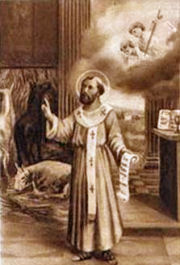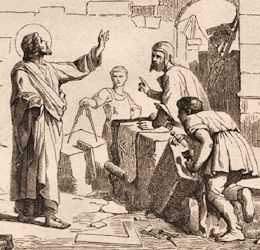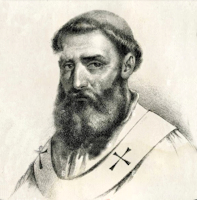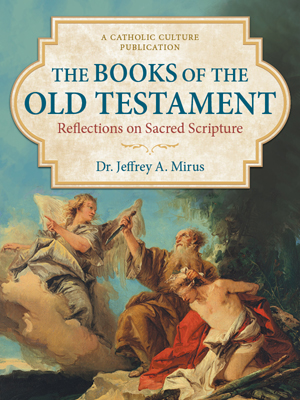Ordinary Time: January 16th
Wednesday of the First Week of Ordinary Time
Other Commemorations: St. Marcellus I, Pope and Martyr (RM); St. Honoratus, Archbishop (RM)
» Enjoy our Liturgical Seasons series of e-books!
According to the 1962 Missal of Bl. John XXIII the Extraordinary Form of the Roman Rite, today is the feast of St. Marcellus who was elected Pope just at the time when Diocletian had spent somewhat his first violence against the Church. In Rome he reorganized the Catholic hierarchy disrupted by the persecution. Before the reform of the Roman Calendar this was the feast of St. Marcellus, pope and martyr.
St. Marcellus
 Diocletian's terrible persecution had taken its toll. It was reported that within a period of thirty days, sixteen thousand Christians were martyred. The Church in Rome was left scattered and disorganized, and the Holy See remained vacant for over two years. It wasn't until the ascension of Emperor Maxentius and his policy of toleration that a pope could be chosen. Marcellus, a Roman priest during the reign of Marcellinus, was elected.
Diocletian's terrible persecution had taken its toll. It was reported that within a period of thirty days, sixteen thousand Christians were martyred. The Church in Rome was left scattered and disorganized, and the Holy See remained vacant for over two years. It wasn't until the ascension of Emperor Maxentius and his policy of toleration that a pope could be chosen. Marcellus, a Roman priest during the reign of Marcellinus, was elected.
Symbols and Representation: Pope with a donkey or horse nearby; pope standing in a stable
Patronage: horses; stablemen; Montemarzo di Asti, Italy
Highlights and Things to Do:
- For further reading, see:
- See the statue of St. Marcellus on St. Peter's Basilica Colonnade.
- St. Marcellus' relics are found in the church in Rome, San Marcello al Corso (Church of Saint Marcellus on the Corso) named after St. Marcello. In this church is the miraculous crucifix that was undamaged in the 1519 fire in Rome.
- As a play on words for Marcellus, perhaps serve a type of Marsala tonight, Chicken Marsala or see the other suggestions in the recipes section.
St. Honoratus
 St. Honoratus was of a consular Roman family settled in Gaul. In his youth he renounced the worship of idols, and gained his elder brother, Venantius, to Christ. Convinced of the hollowness of the things of this world, they wished to renounce it with all its pleasures, but a fond pagan father put continual obstacles in their way. At length, taking with them St. Caprais, a holy hermit, for their director, they sailed from Marseilles to Greece, with the intention to live there unknown in some desert.
St. Honoratus was of a consular Roman family settled in Gaul. In his youth he renounced the worship of idols, and gained his elder brother, Venantius, to Christ. Convinced of the hollowness of the things of this world, they wished to renounce it with all its pleasures, but a fond pagan father put continual obstacles in their way. At length, taking with them St. Caprais, a holy hermit, for their director, they sailed from Marseilles to Greece, with the intention to live there unknown in some desert.
Venantius soon died happily at Methone, and Honoratus, being also sick, was obliged to return with his conductor. He first led a hermitical life in the mountains near Frejus. Two small islands lie in the sea near that coast; on the smaller, now known as St. Honoré, our Saint settled, and, being followed by others, he there founded the famous monastery of Lerins, about the year 400. Some of his followers he appointed to live in community; others, who seemed more perfect, in separate cells as anchorets. His rule was chiefly borrowed from that of St. Pachomius.
Nothing can be more amiable than the description St. Hilary has given of the excellent virtues of this company of saints, especially of the charity, concord, humility, compunction, and devotion which reigned among them under the conduct of our holy abbot.
He was, by compulsion, consecrated Archbishop of Arles in 426, and died, exhausted with austerities and apostolical labors, in 429.
—Excerpted from Lives of the Saints, by Alban Butler, Benziger Bros. ed. [1894]
Symbols and Representation: bishop drawing water from a rock with his mitre nearby; bishop on Lérins with a phoenix nearby; driving snakes from Lérins; overseeing the construction of the abbey at Lérins
Patronage: against drought; against misfortune; against rain; for rain; Arles, France
Highlights and Things to Do:
- Read more about St. Honoratus:
- St. Honoratus founded Lerins Abbey on now called St. Honorat Island, which is an active Cistercian monastery. See this site for more information.






